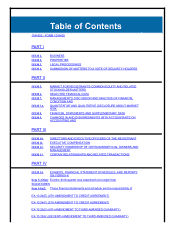AMD 1997 Annual Report Download - page 11
Download and view the complete annual report
Please find page 11 of the 1997 AMD annual report below. You can navigate through the pages in the report by either clicking on the pages listed below, or by using the keyword search tool below to find specific information within the annual report.convert from 0.35 micron to 0.25 micron process technology in its Fab 25 in
Austin, Texas as soon as possible in order to meet customer microprocessor
needs for performance and volume, and to compete successfully against Intel.
The Company's process technology transition schedule is aggressive and entails
a high degree of risk. The Company's 0.25 micron process technology, while
successfully put into production in the Company's Submicron Development Center
in Sunnyvale, California, has not been qualified in Fab 25. There can be no
assurance that the Company will execute a successful transition to 0.25 micron
process technology in Fab 25, or that the Company will achieve the production
ramp necessary to meet customer needs for higher performance AMD-K6
microprocessors in the volumes customers require, or that the Company will
increase revenues sufficient to achieve profitability in the microprocessor
business. The failure to convert Fab 25 to 0.25 micron process technology on a
timely basis could adversely affect unit production yields and volumes, result
in the failure to meet customer demands, cause customers to cease purchasing
AMD-K6 microprocessors, and could impact the viability of the Company's
microprocessor business, any of which would have a material adverse effect on
the Company.
AMD is also devoting substantial resources to the development of its seventh-
generation Microsoft Windows compatible microprocessor. The success of the AMD-
K7 and future generations of microprocessors depends greatly on the Company
achieving success and increasing market share with the AMD-K6 microprocessor.
Intel has long held a dominant position in the market for microprocessors
used in PCs. Intel Corporation's dominant market position enables it to set and
control x86 microprocessor standards and thus dictate the type of product the
market requires of Intel Corporation's competitors. In addition, Intel
Corporation's financial strength and dominant position enable it to vary prices
on its microprocessor products at will and thereby affect the margins and
profitability of its competitors. In view of Intel Corporation's industry
dominance and brand strength, AMD prices the AMD-K6 microprocessor at least 25
percent below the published price of Intel processors offering comparable
performance. Thus, Intel Corporation's decisions on processor prices can impact
and has impacted the average selling prices of the AMD-K6 microprocessors, and
consequently can impact and has impacted the Company's margins. As an extension
of its dominant microprocessor market share, Intel also now dominates the PC
platform, which has made it difficult for PC manufacturers to innovate and
differentiate their product offerings. The Company does not have the financial
resources to compete with Intel on such a large scale.
As Intel has expanded its dominance over the entirety of the PC system
platform, many PC original equipment manufacturers (OEMs) have reduced their
system development expenditures and have begun to purchase microprocessors in
conjunction with core logic chipsets or in assembled motherboards. The trend
has been for PC OEMs to be increasingly dependent on Intel, less innovative on
their own, and more of a distribution channel for Intel technology. In
marketing its microprocessors to these OEMs and dealers, AMD depends upon
companies other than Intel for the design and manufacture of chipsets,
motherboards, basic input/output system (BIOS) software and other components.
In recent years, these third-party designers and manufacturers have lost
significant market share to Intel. In addition, these companies are able to
produce chipsets, motherboards, BIOS software and other components to support
each new generation of Intel Corporation's microprocessors only if Intel makes
information about its products available to them in time to address market
opportunities. Delay in the availability of such information makes, and will
continue to make, it increasingly difficult for them to retain or regain market
share. To compete with Intel in this market in the future, the Company intends
to continue to form closer relationships with third-party designers and
manufacturers of chipsets, motherboards, BIOS software and other components.
The Company similarly intends to expand its chipset and system design
capabilities, and to offer OEMs licensed system designs incorporating the
Company's processors and companion products. There can be no assurance,
however, that such efforts by the Company will be successful.
VANTIS CORPORATION
In 1997, the Company transferred its operations relating to the design,
development and marketing of programmable logic devices (excluding bipolar
products) to a wholly owned subsidiary, Vantis Corporation (Vantis). Vantis
does not fabricate any of the silicon wafers used in the production of its
products. As a result, Vantis relies on the Company and others for
manufacturing. In addition, Vantis relies on the Company for certain
administrative and other services.
8
Source: ADVANCED MICRO DEVIC, 10-K405, March 03, 1998
























